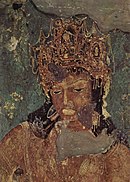Narendrasena
| Narendrasena | |
|---|---|
| Maharaja | |
| Vakataka king of Nandivardhana-Pravarapura | |
| Reign | c. 455 – 480 CE |
| Predecessor | Pravarasena II |
| Successor | Prithivishena II |
| Spouse | Ajjhitabhattarika |
| Dynasty | Vakataka |

| Vakataka dynasty c. 250 - 510 CE | ||||||||||||||||
|---|---|---|---|---|---|---|---|---|---|---|---|---|---|---|---|---|
|
||||||||||||||||
| Nandivardhana-Pravarapura Branch | ||||||||||||||||
|
||||||||||||||||
| Vatsagulma Branch | ||||||||||||||||
|
||||||||||||||||
Narendrasena (r. c. 455 – 480 CE[1]) was a ruler of the Nandivardhana-Pravarapura branch of the Vakataka dynasty. He succeeded his father Pravarasena II as Maharaja.
Early life
Narendrasena was possibly born to Ajnakabhattarika, who may have been the chief queen of Pravarasena II and is mentioned as the mother of "Narindaraja" (possibly referring to Narendrasena) in a charter from Pravarasena's 16th regnal year.[2] Sometime during his father's reign, Narendrasena was married to a princess named Ajjhitabhattarika who was described as the daughter of the "king of Kuntala". It is not known for certain who this "king of Kuntala" was, but he is often identified with the Kadamba king Kakusthavarman who is known to have married his daughters into several prominent royal families.[3][4][5]
Reign
The death of Pravarasena II may have been followed by a succession struggle, from which Narendrasena emerged victorious.[6] The Vakataka records state that Narendrasena had to "regain the fortunes of his family" after suffering some undisclosed calamity, which several historians have interpreted as referring to this supposed war of succession after his father's death. However, A.S. Altekar argues that the records instead refer to an invasion of the Vakataka realm by the Nala king Bhavadattavarman of the Bastar region, who is known to have penetrated deep into Vidarbha and occupied Nandivardhana, the erstwhile Vakataka capital.[7] Altekar supposes that Narendrasena successfully drove out the Nalas from his kingdom shortly after the death of Bhavadattavarman.
The inscriptions of Prithivishena II, Narendrasena's son and successor, assert that Narendrasena's authority was acknowledged by the rulers of Kosala, Mekala, and Malava.[3][8] Many historians regard this claim to be an empty boast or exaggeration, but it is possible that Narendrasena had indeed greatly expanded the Vakataka sphere of influence. The Gupta Empire, then the hegemonic power in northern India, was embroiled in a war with invading Huna hordes, which left the Vakatakas free to expand into central India.[9] It is also possible that Narendrasena's prosecution of the war against the Nalas resulted in the further extension of Vakataka authority, especially in the area around present-day Chhattisgarh. Narendrasena might have invaded the Nala homeland and sacked their capital, for Skandavarman, a brother and successor of Bhavadattavarman, is said to have retrieved the fortunes of his family and had to repopulate his capital.[7]
References
- ^ Shastri, Ajay Mitra (1997). Vakatakas: Sources and History. Aryan Books International. p. 212. ISBN 9788173051234.
- ^ Bakker, Hans (1997). The Vakatakas: An Essay in Hindu Iconology. Groningen: Egbert Forsten. p. 24. ISBN 9069801000.
- ^ a b D.C. Sircar (1997). Majumdar, R.C. (ed.). The Classical Age (Fifth ed.). Bharatiya Vidya Bhavan. p. 184.
- ^ A.S. Altekar (2007). Majumdar, R.C.; Altekar, A.S. (eds.). The Vakataka-Gupta Age. Motilal Banarsi Dass. p. 106. ISBN 9788120800434.
- ^ Sastri, K.A. Nilakanta (1961). A History of South India from Prehistoric Times to the Fall of Vijayanagar (Third ed.). Oxford University Press. p. 109.
- ^ Singh, Upinder (2016). A History of Ancient and Early Medieval India From the Stone Age to the 12th Century. Pearson India Education Services. p. 484. ISBN 9788131716779.
- ^ a b A.S. Altekar (2007). Majumdar, R.C.; Altekar, A.S. (eds.). The Vakataka-Gupta Age. Motilal Banarsi Dass. pp. 106–109. ISBN 9788120800434.
- ^ Bakker (1997), p. 29
- ^ "Vakataka dynasty | Indian history | Britannica". Britannica. Britannica. Retrieved 26 January 2021.


